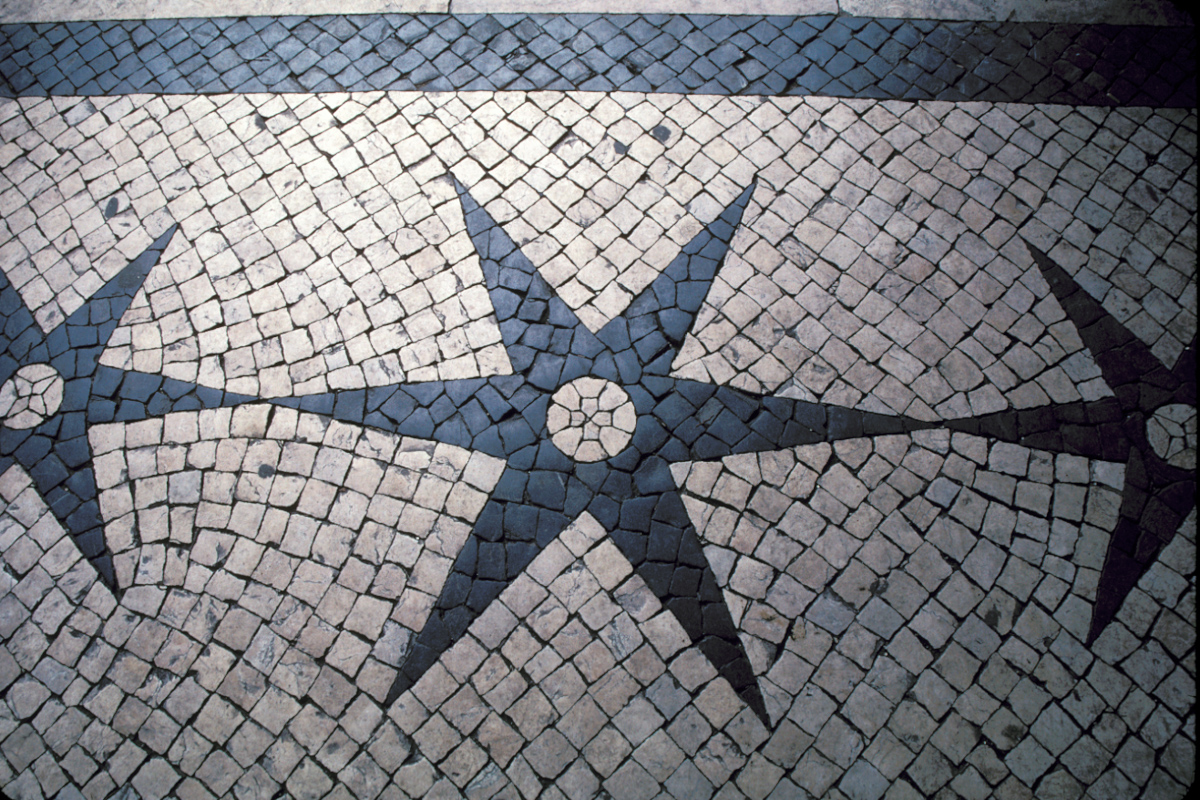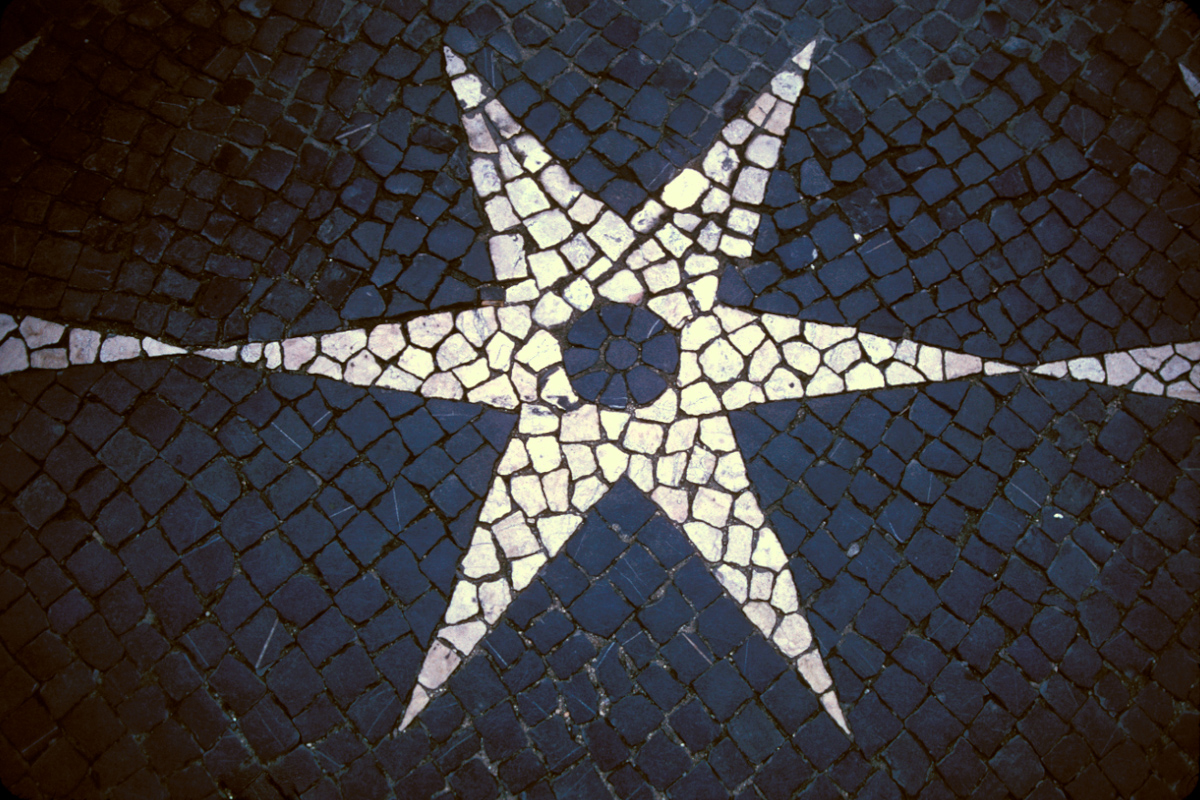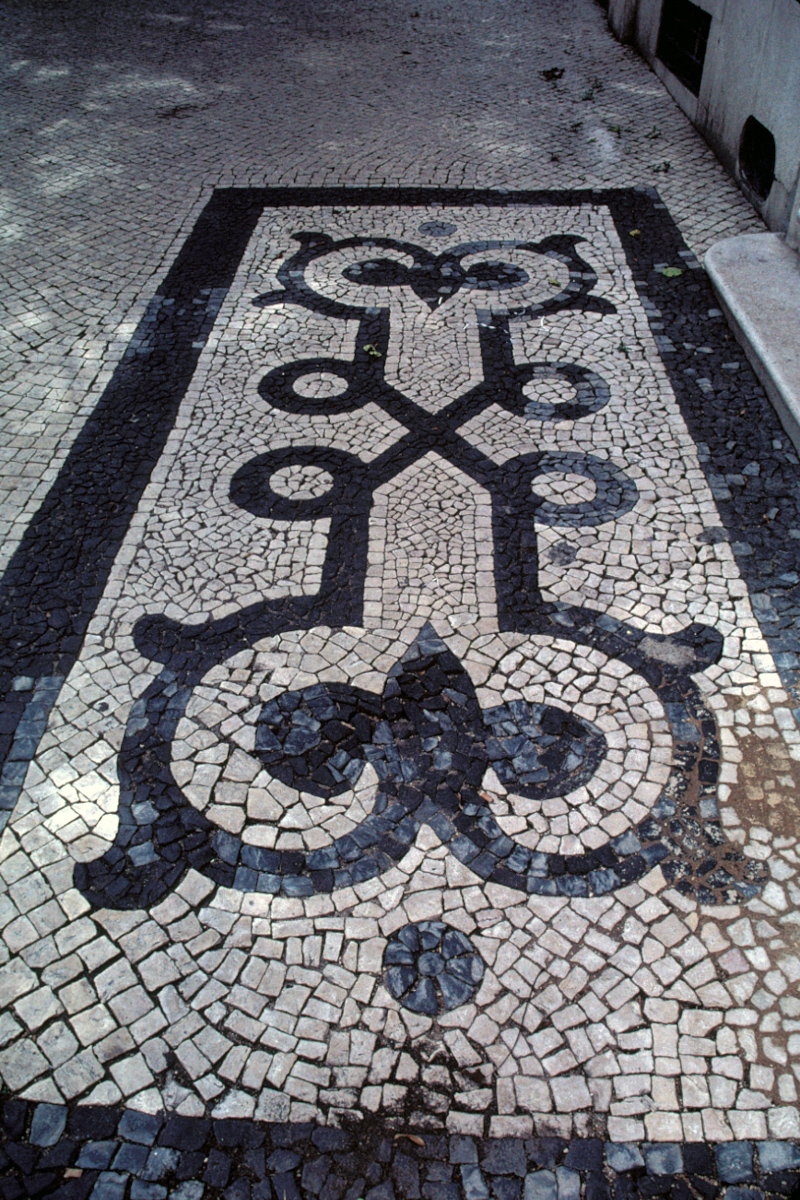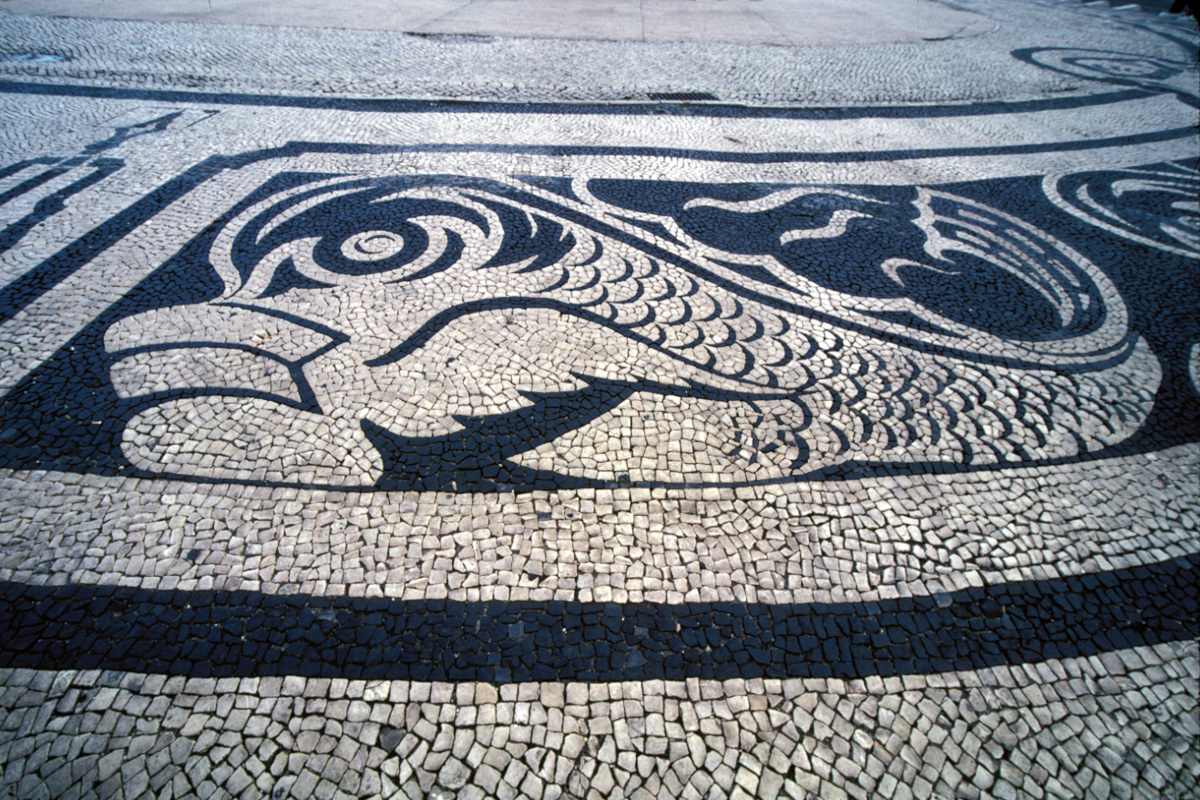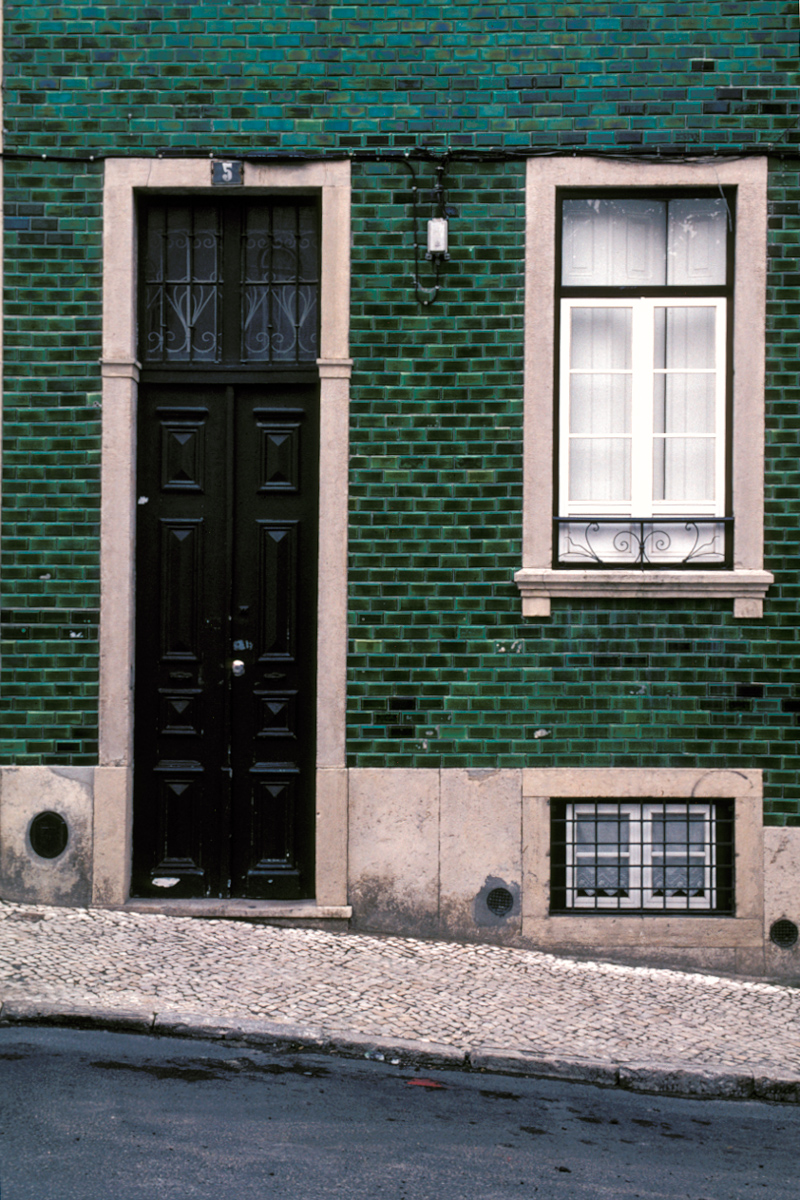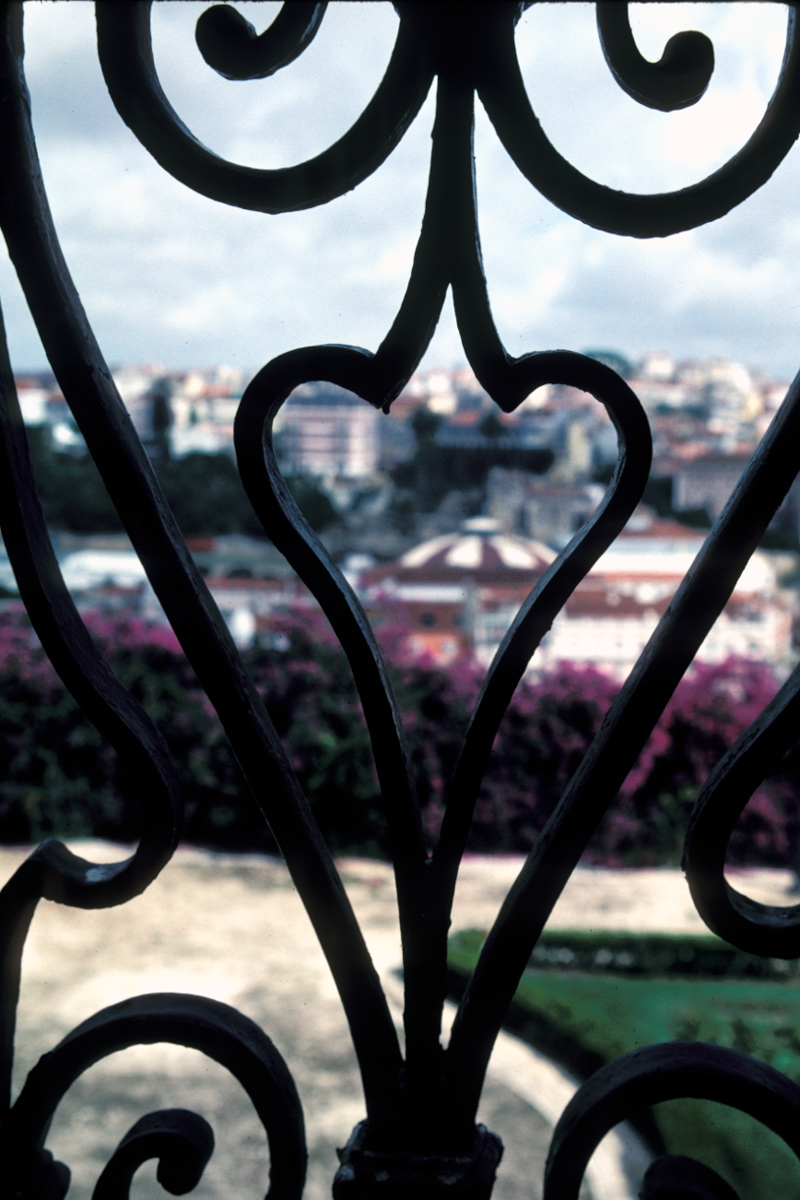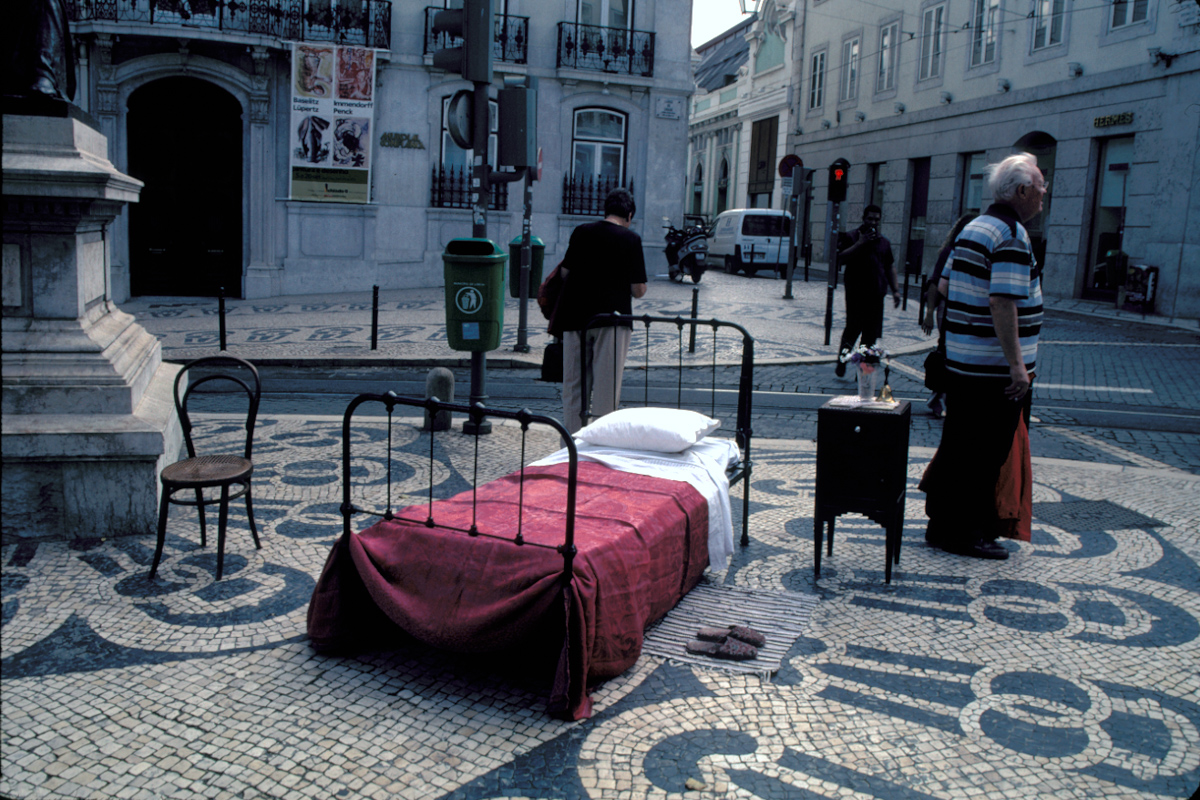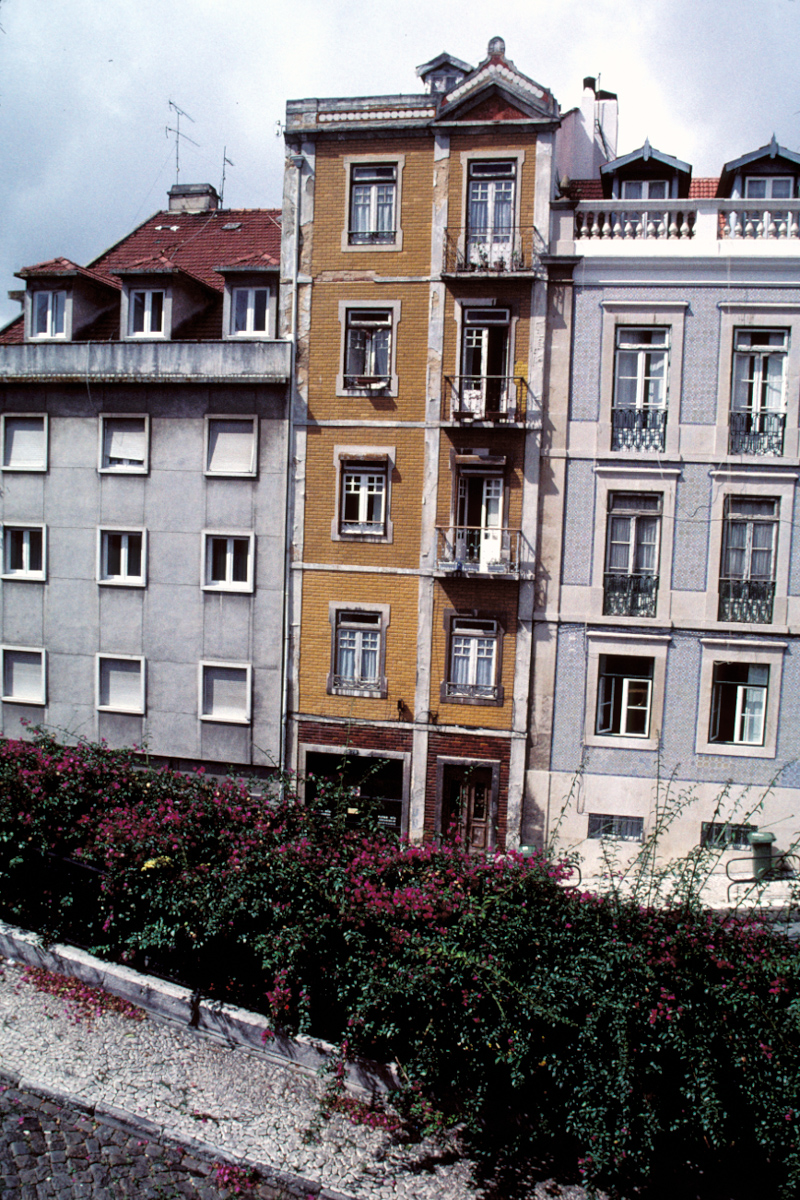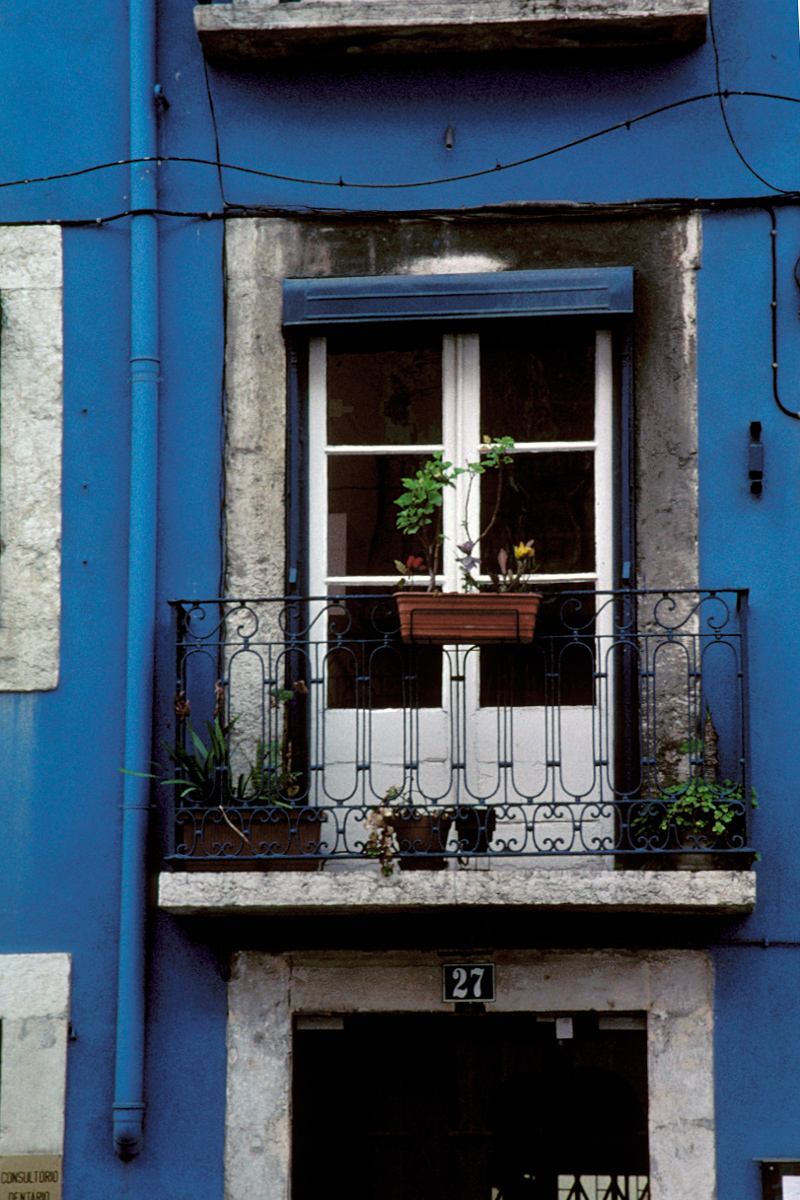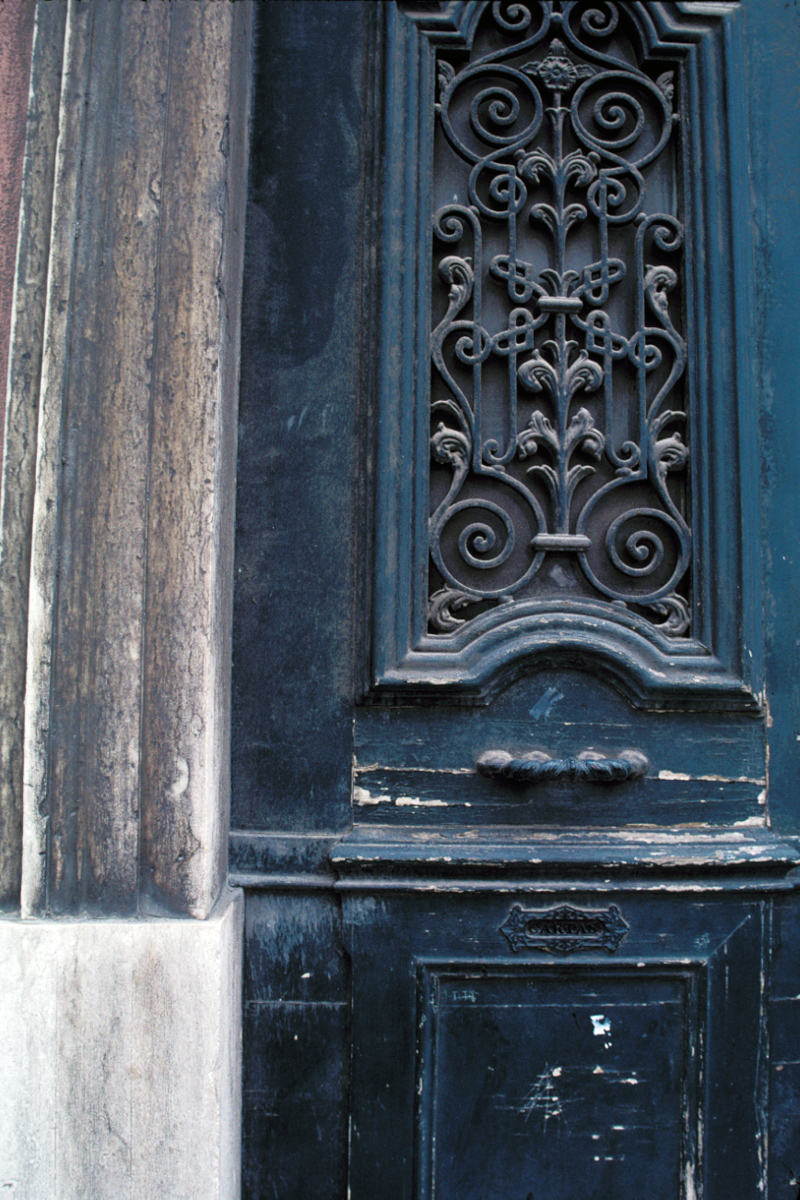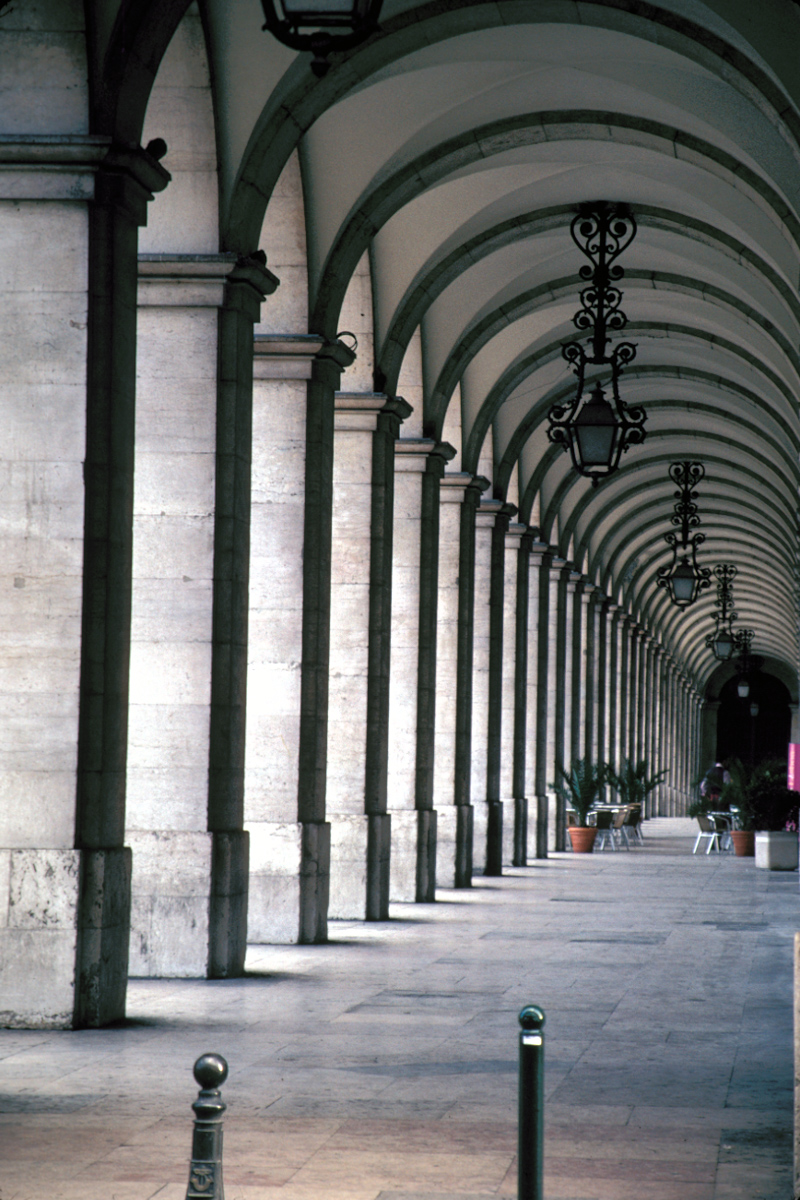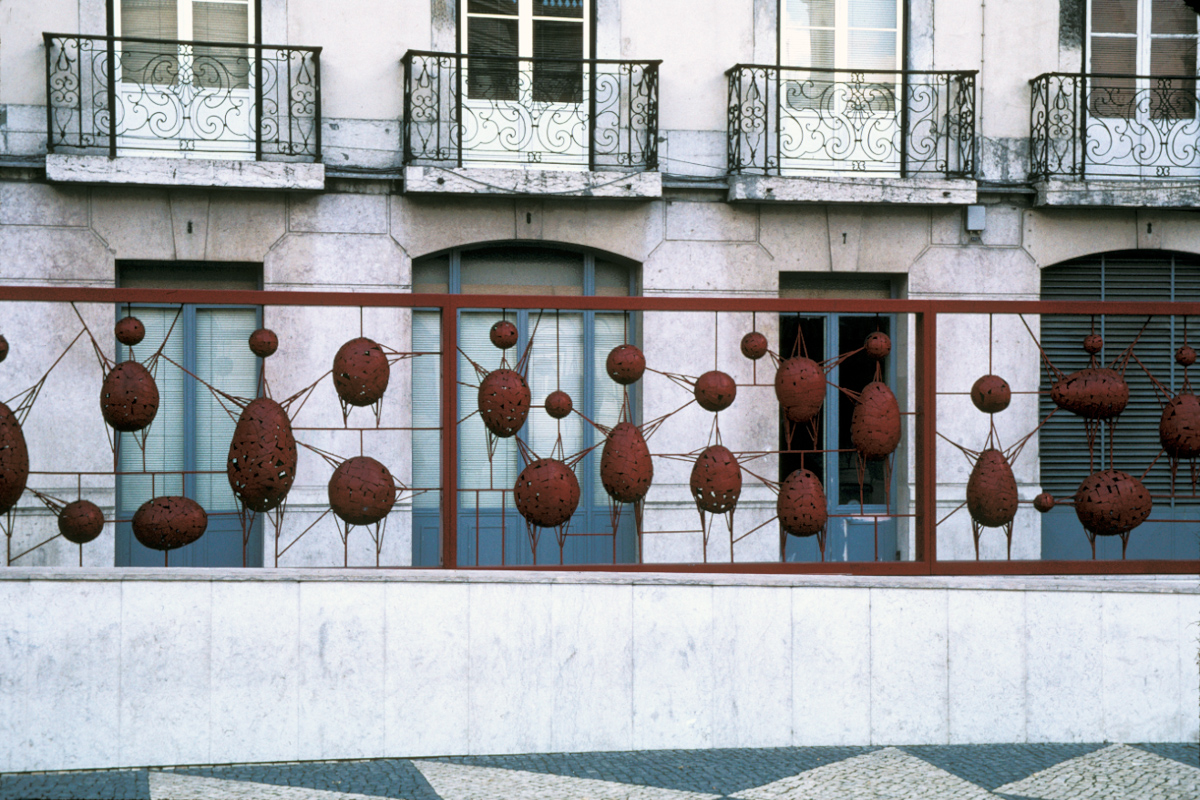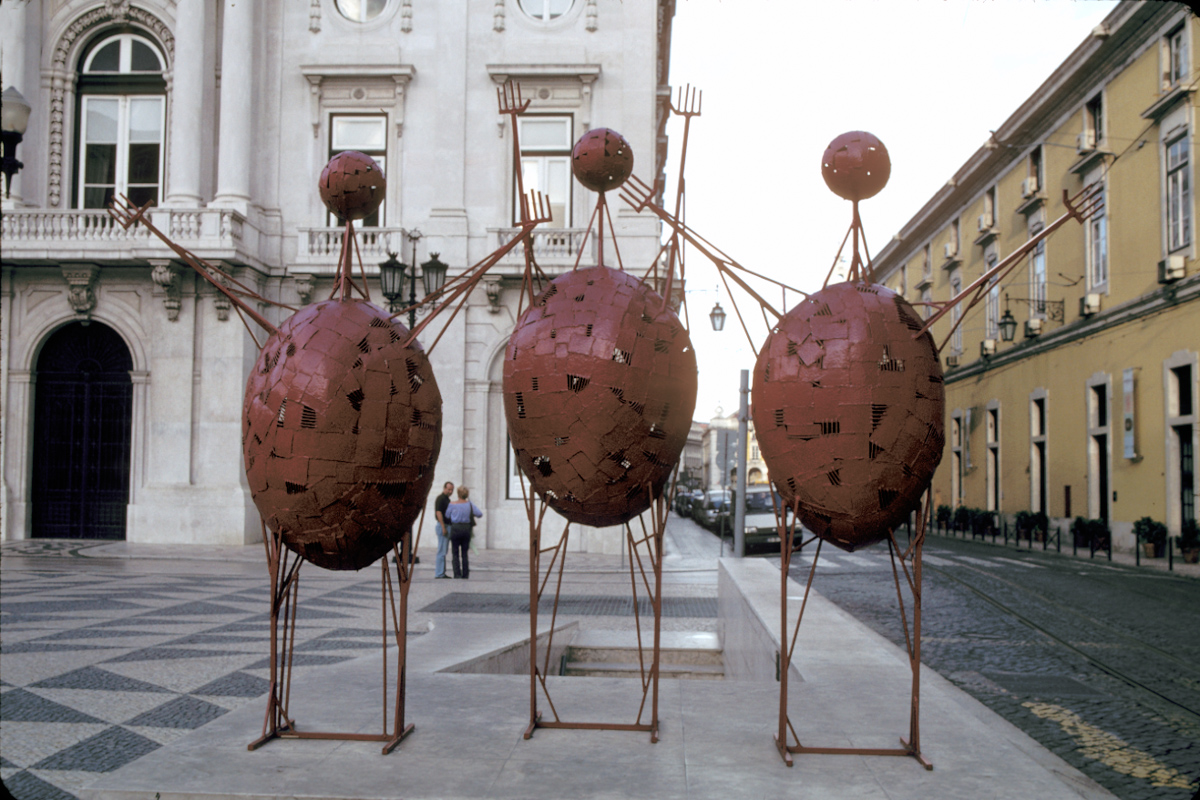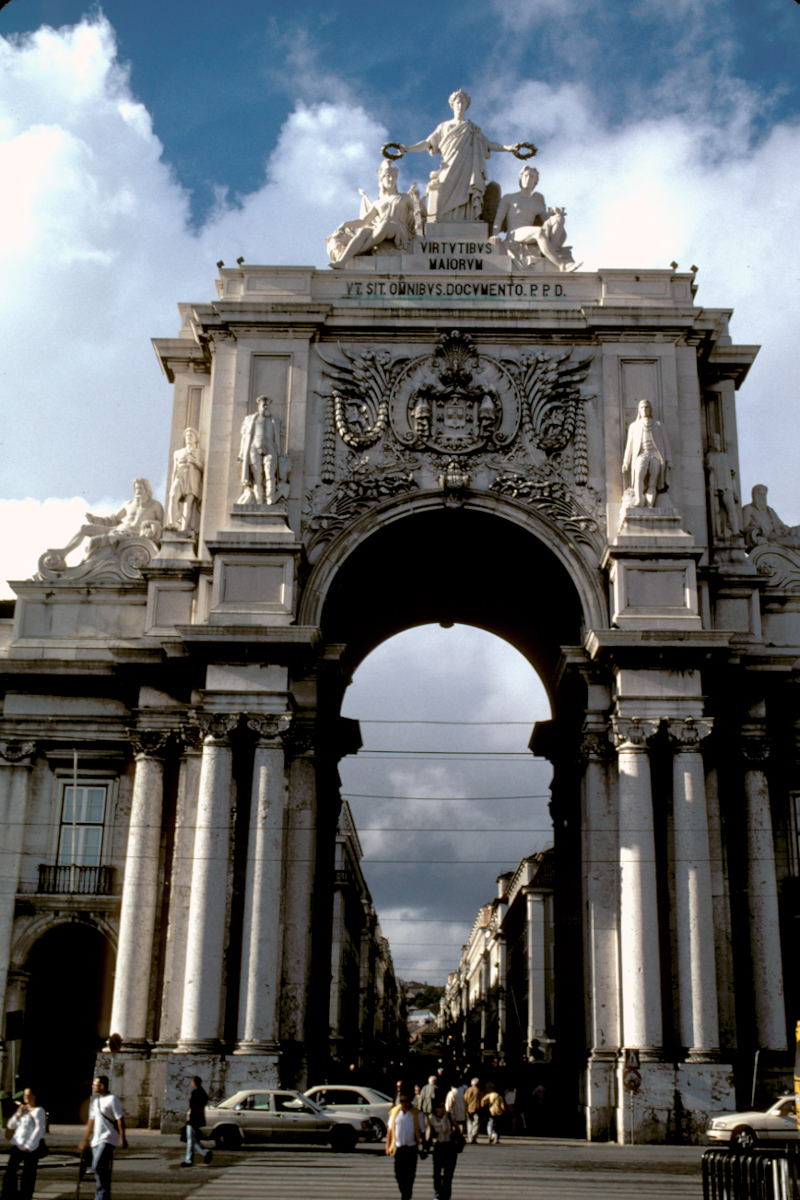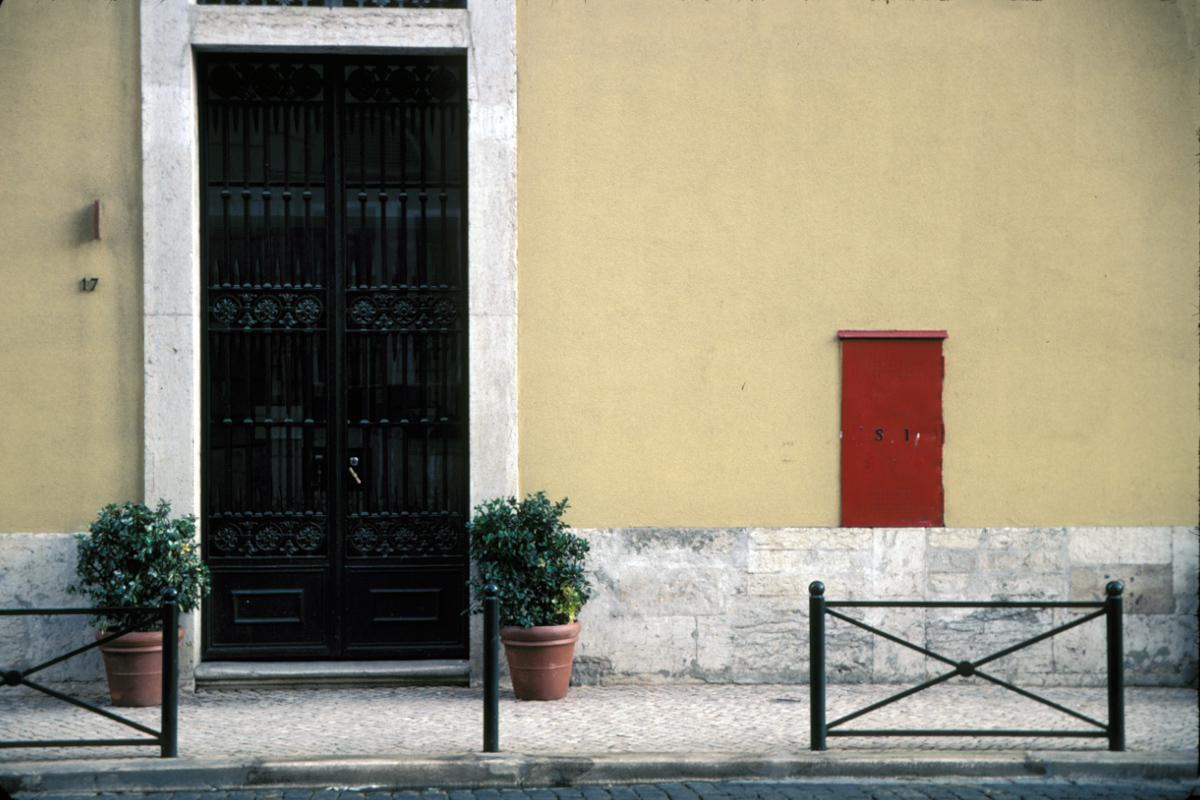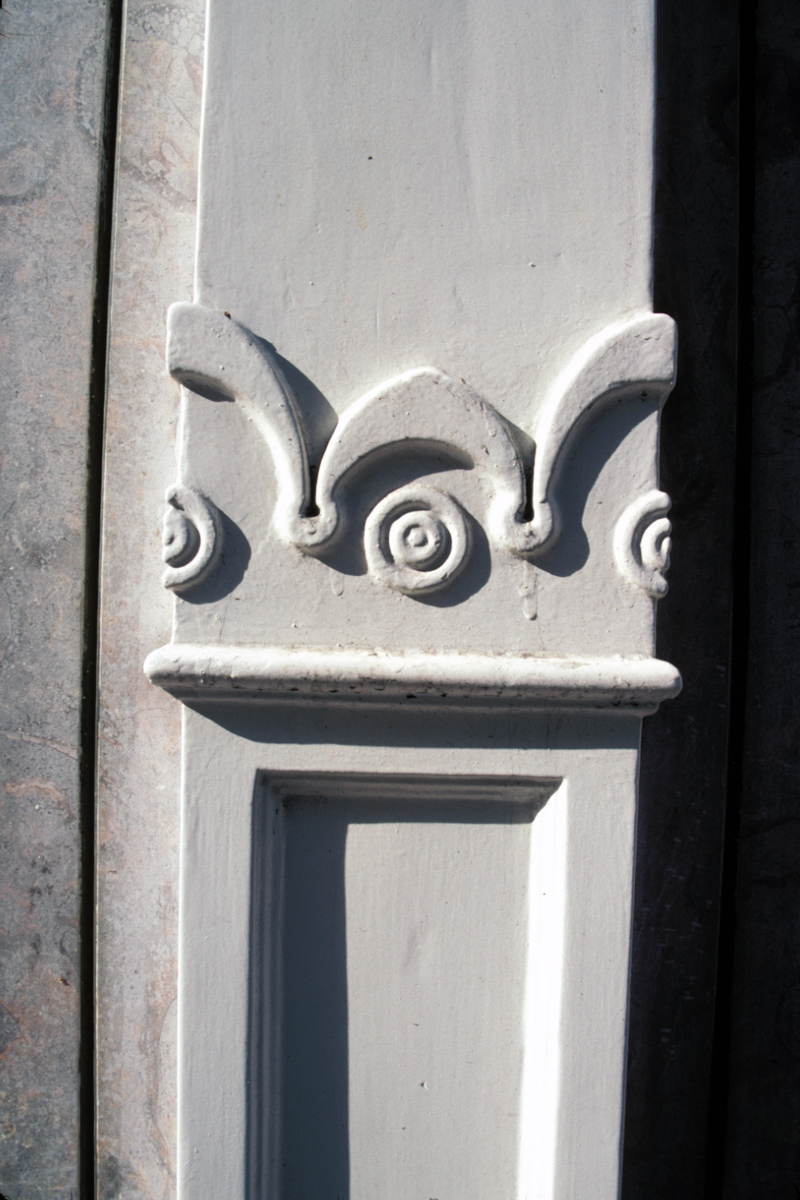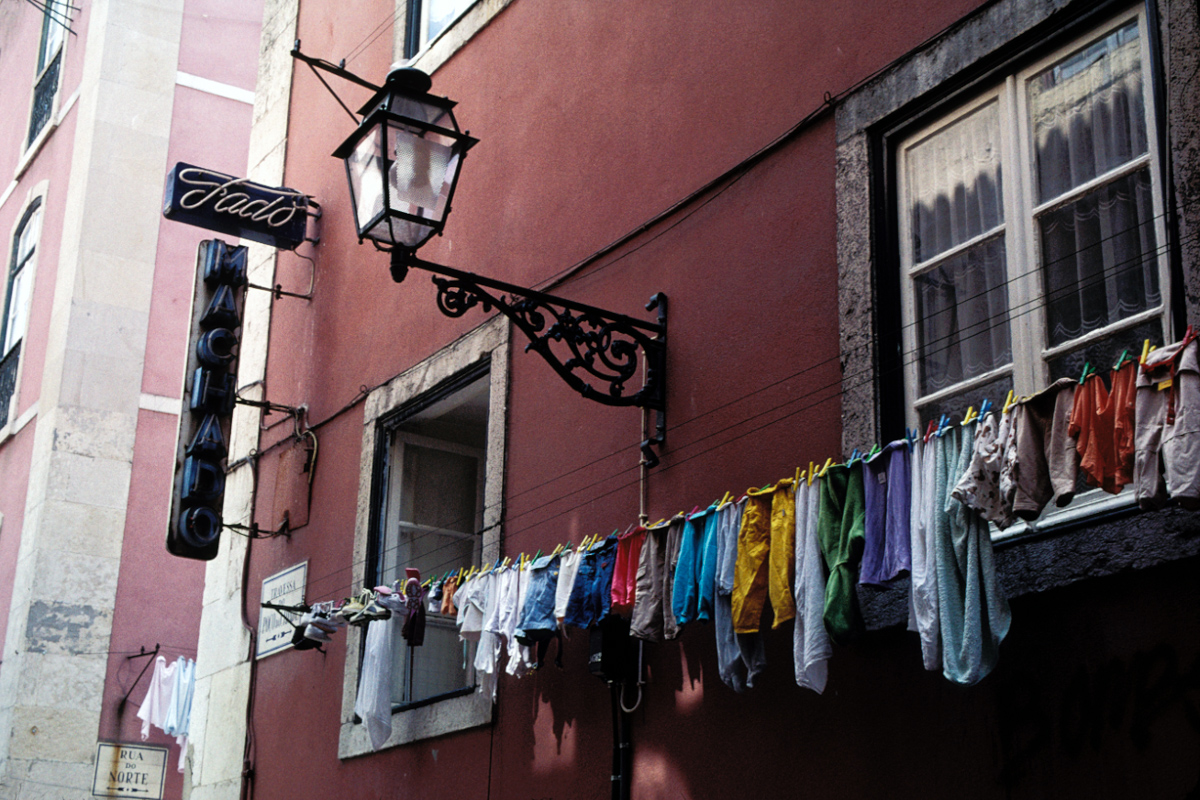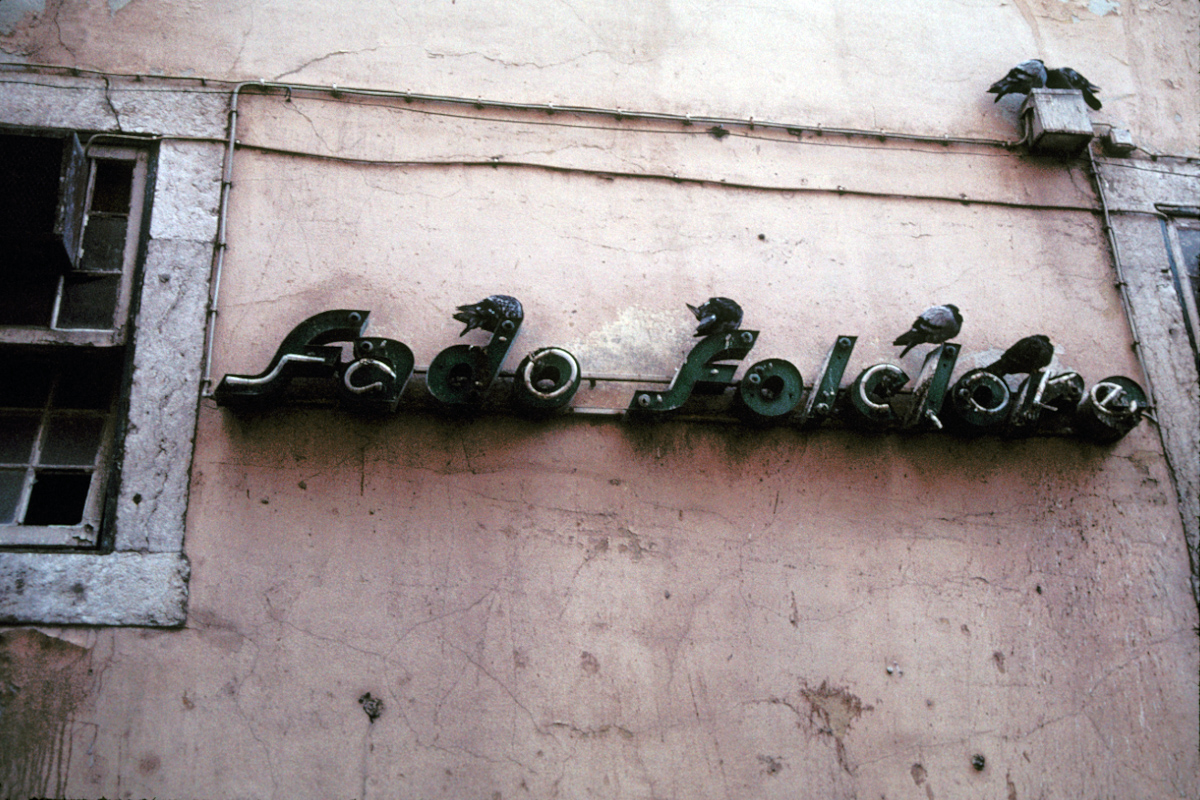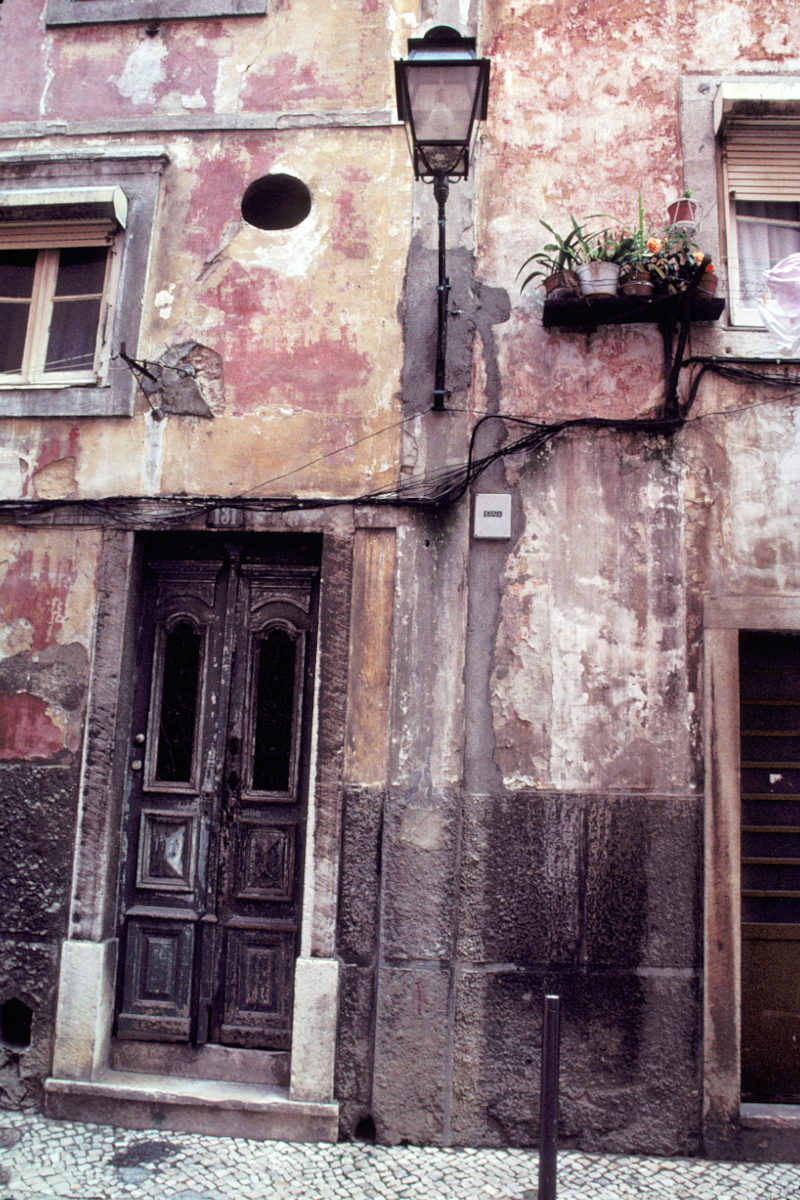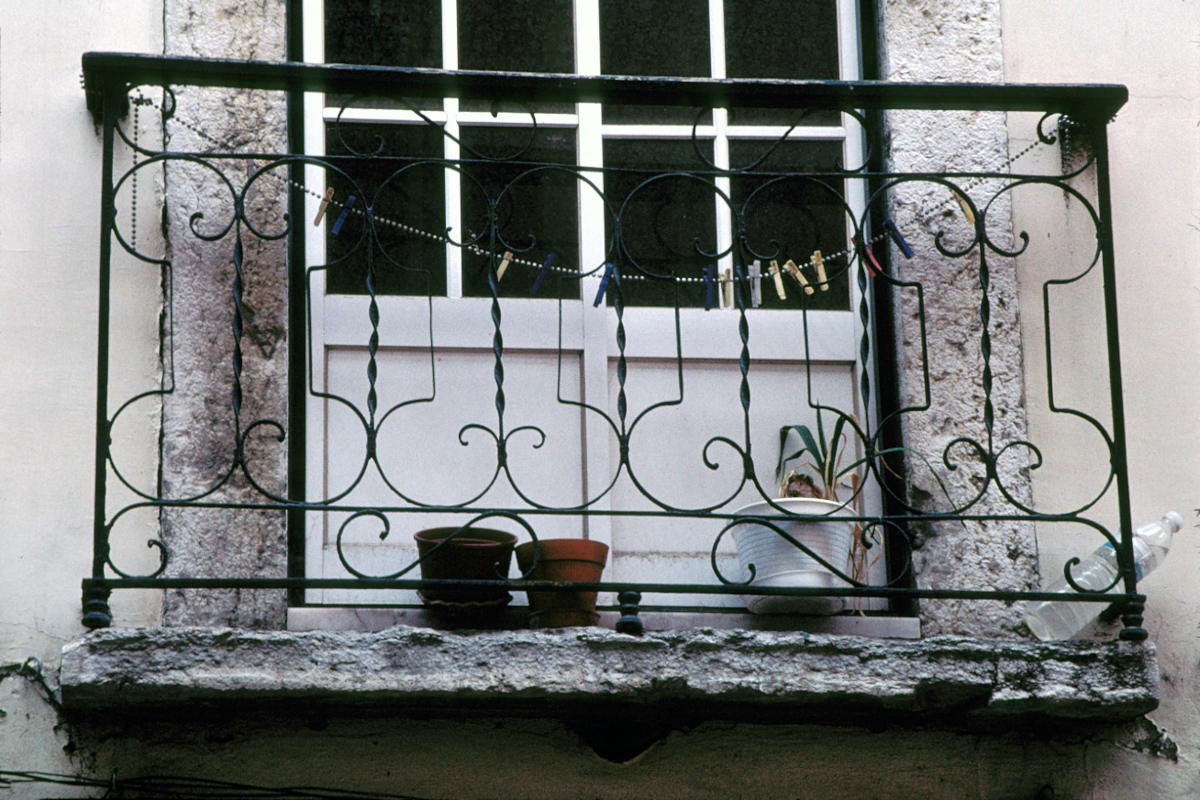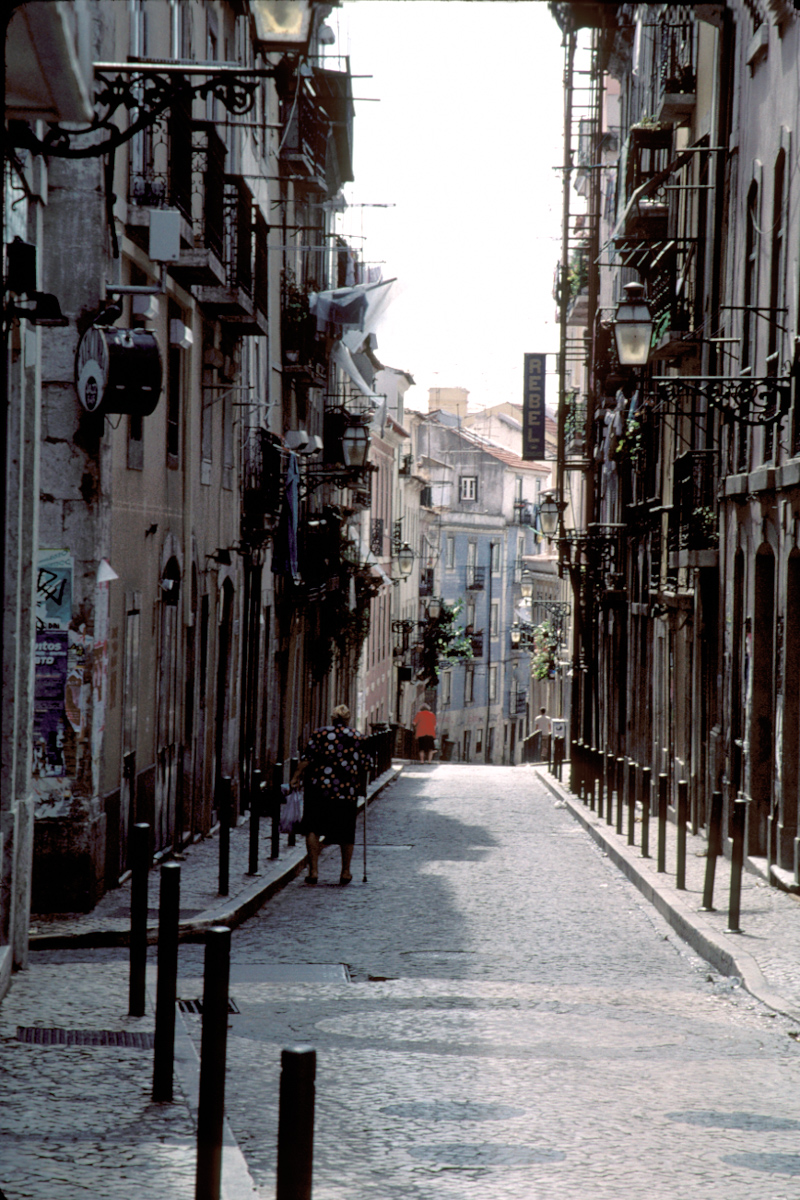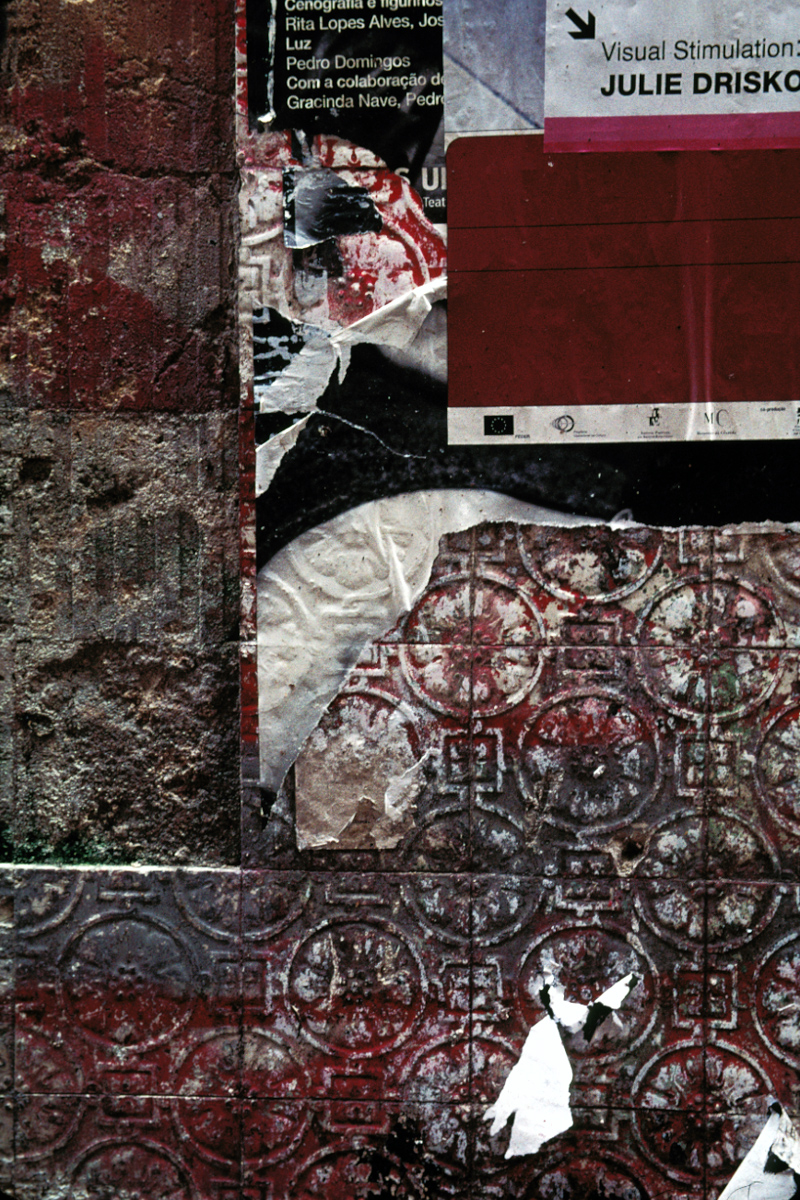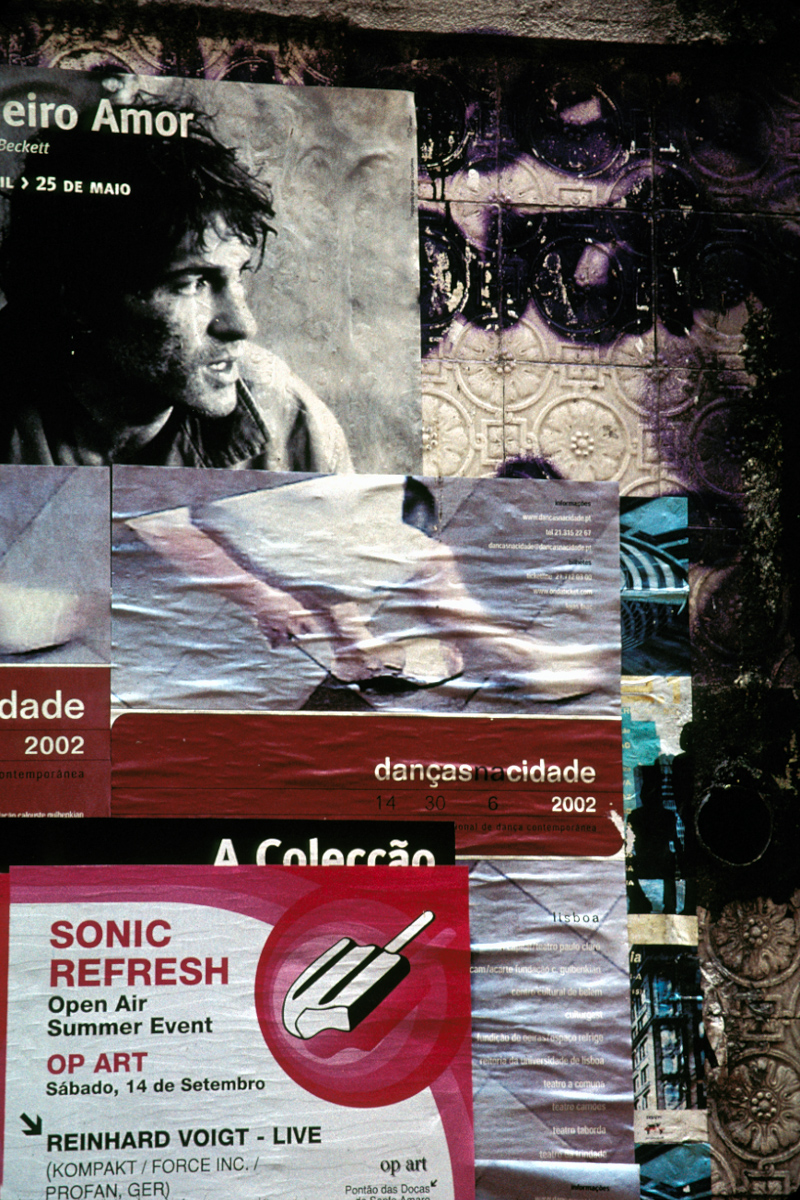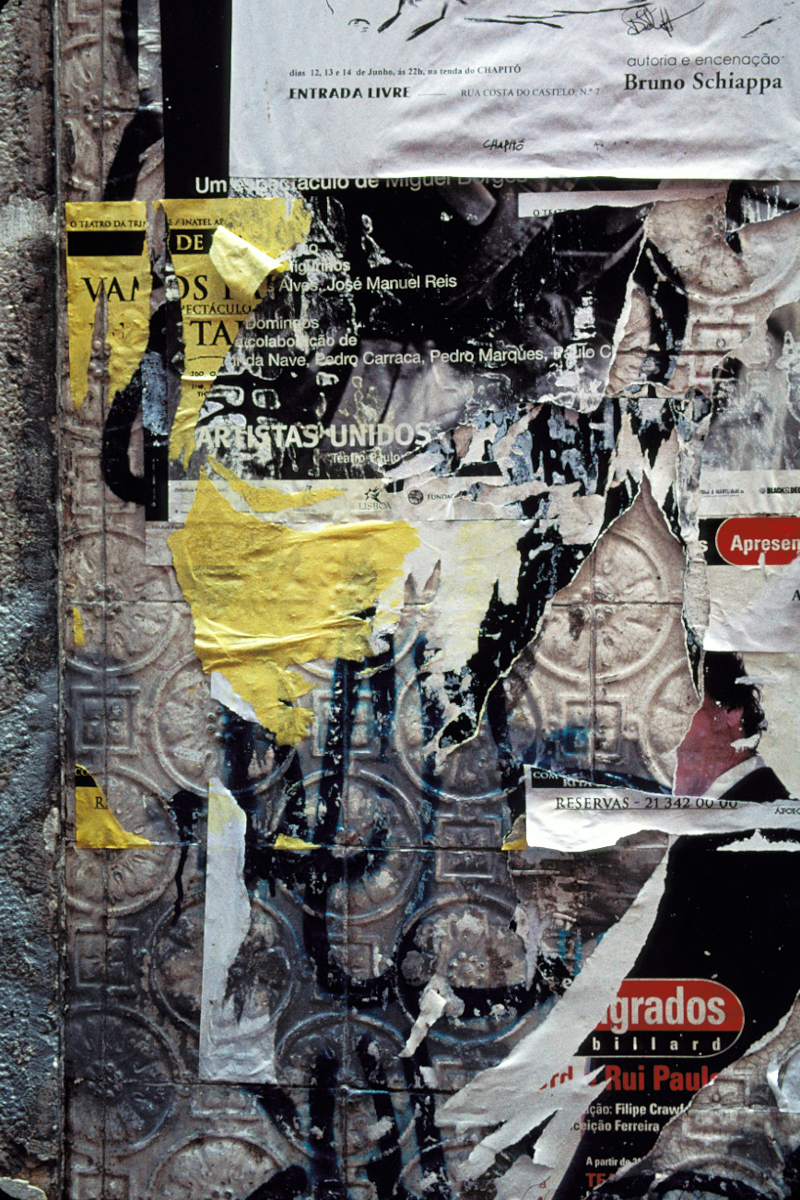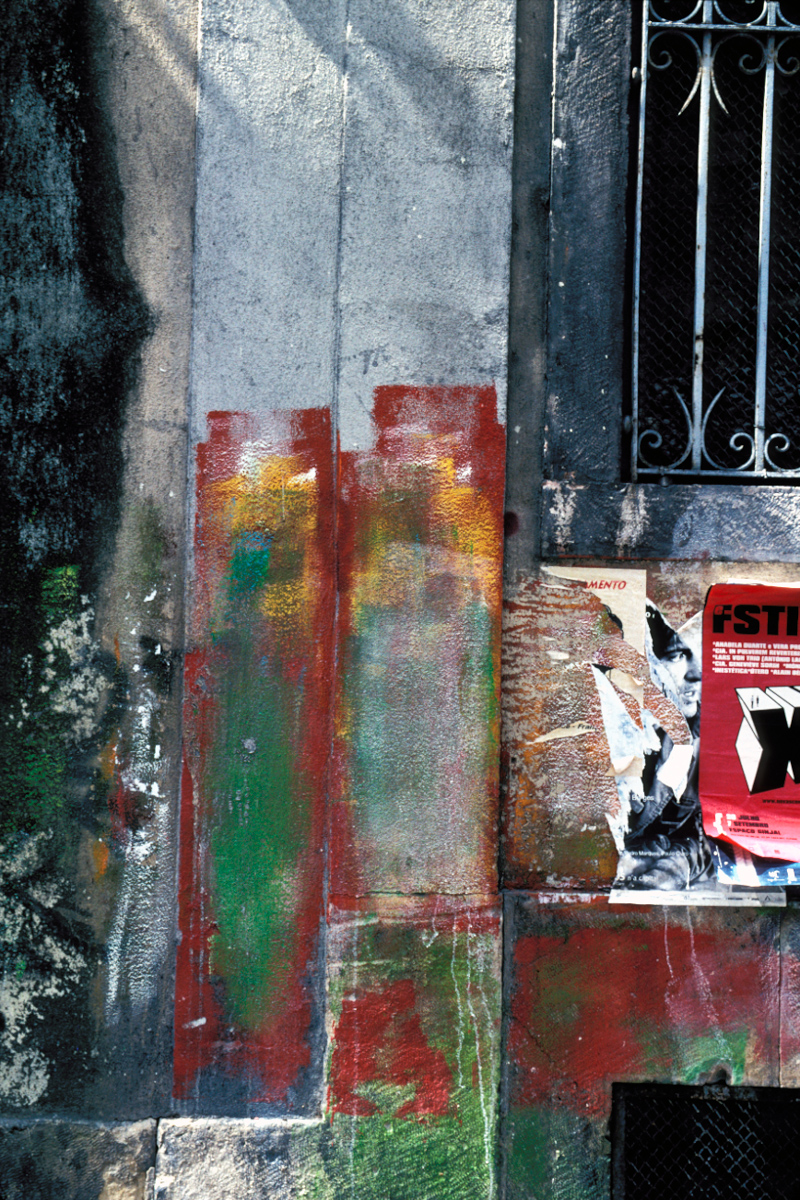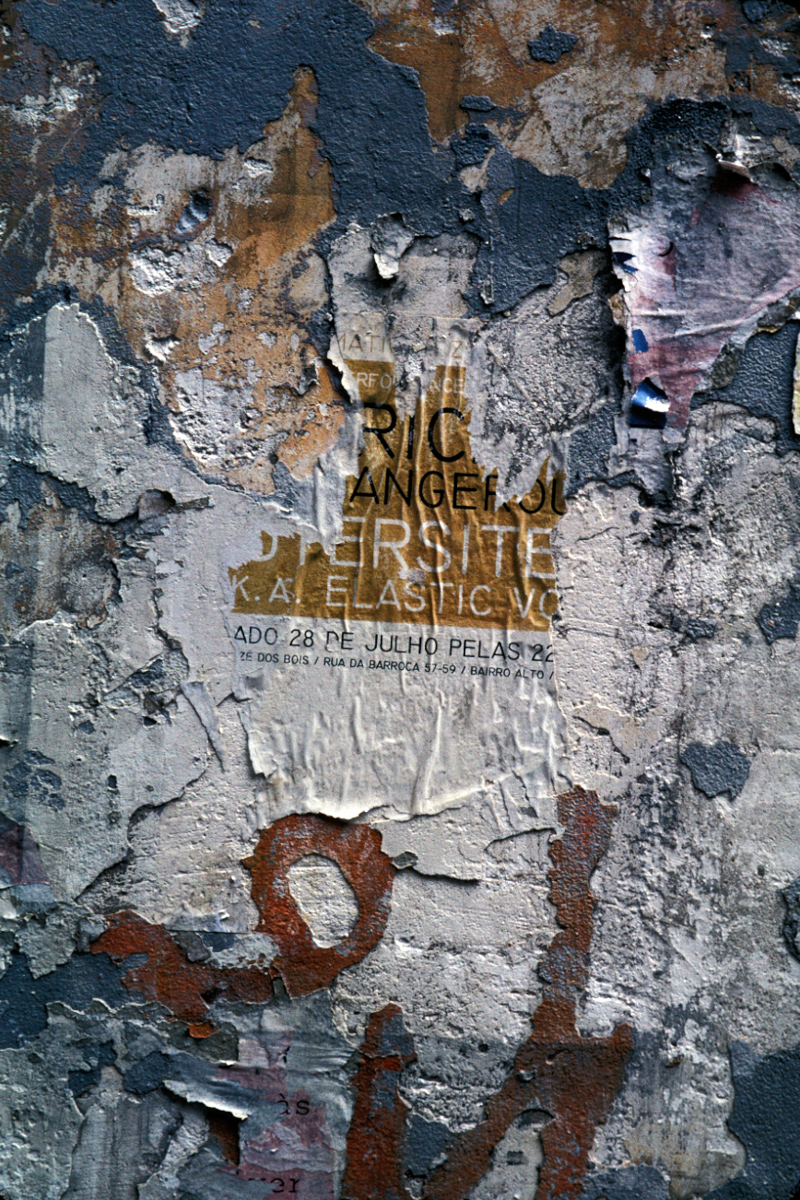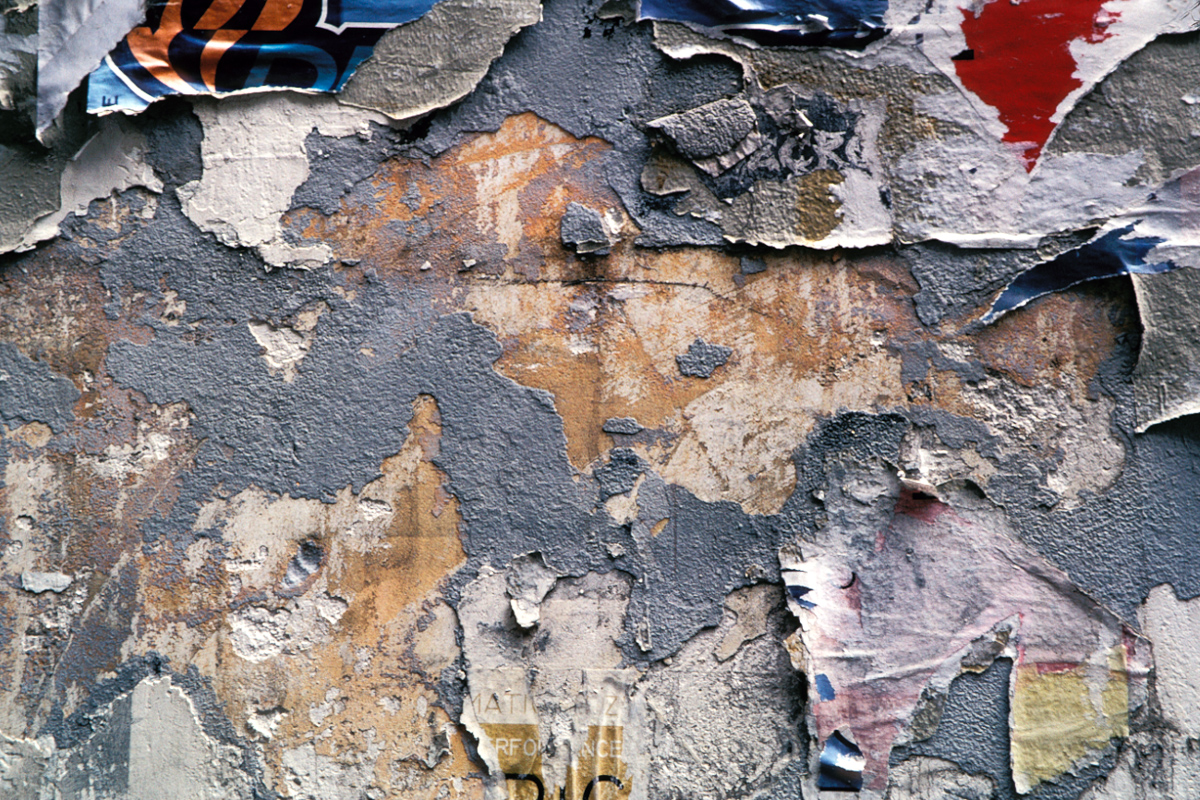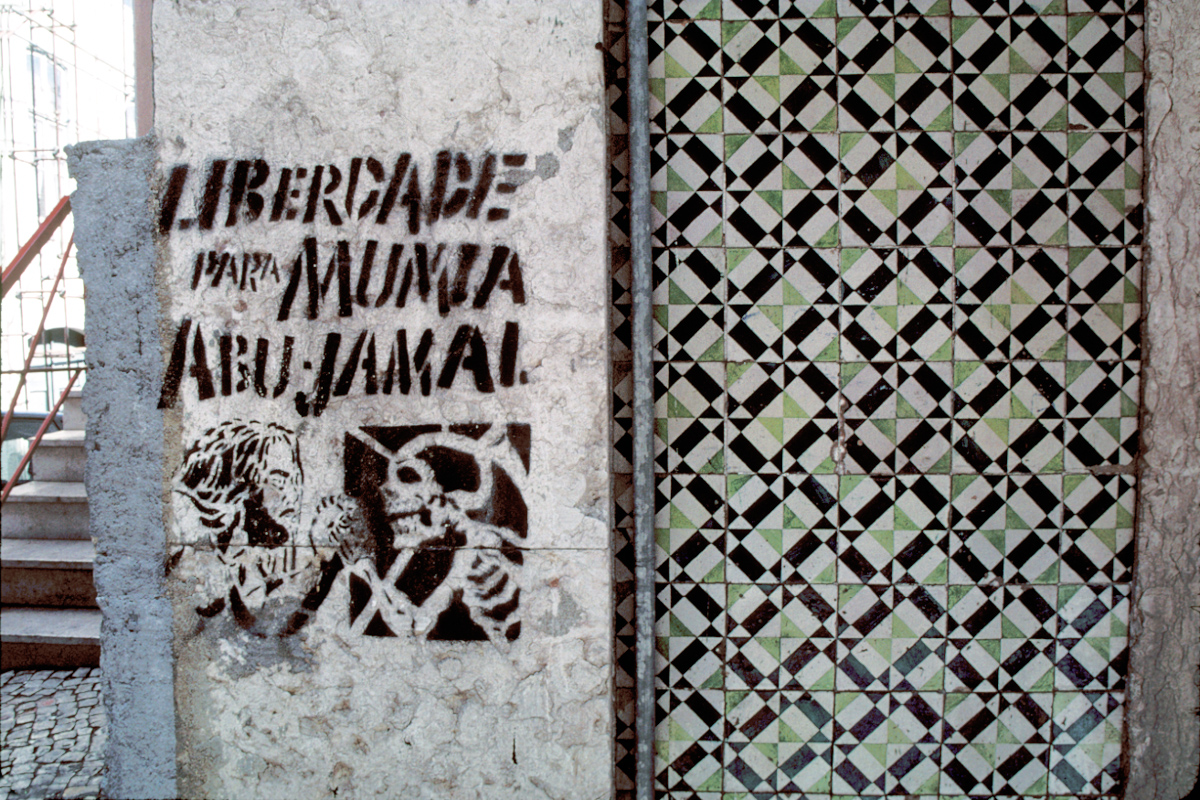On our last morning in Salema, we slept in a bit, mostly because I hadn’t slept very well. We made some tea and ate the biscuits we’d bought the night before. I was feeling a little light-headed and queasy – perhaps somehow related to our carousing the previous evening? I ended up sitting out on the patio, drinking some water and getting some fresh air, while Dan finished getting ready.
We caught up with Leeza to settle the bill, and chatted with her a bit about tourism in Salema, getting listed in the Rick Steves guidebook, the Portuguese disposition, and a few other things. She was very friendly, and very talkative. She graciously offered to give us a ride down into town so we could get lunch before we headed back to Lagos.
Getting There
For the sake of convenience, we decided to get lunch right on the town square, at a place that served mainly salads and pizzas. Due to a misunderstanding about whether Dan was ordering for both of us or just himself, we had a funny running gag with the waitress about what was for me and what was for him. (Greek salad for me, Greek salad and grilled chicken in piri piri sauce for Dan.) It was a good lunch, simple and tasty.
Time was starting to grow tight, so Dan went over to the taxi stand to see if we could get a cab to take us back to Lagos. As he was about to call, a taxi pulled into the square with some passengers. He tried to flag it, but the driver didn’t see him. At this point, Dan saw the bus, which only runs once an hour, at the top of the square. I had already paid the bill, so we grabbed our bags and sprinted up the hill to catch the bus. Luckily, we made it!
The bus wound its way back to Lagos, stopping at completely unmarked stops and letting people off in the middle of the road. This puzzled us. How did people know, without a marker, where the bus would stop? Do all the locals just know to stand at, say, the fourth olive tree on the left?
Back in Lagos, Dan got our tickets for Lisbon while I made another stop in the nasty bathroom with no toilet seat or paper. As an added treat this time, there were various old men loitering in the station who seemed to enjoy leering at any woman going by.
We got on the bus for Lisbon, which was staffed with a grumpy stewardess. Once we got on the road, she glowered her way up and down the center aisle, selling cans of soda, bagged snacks, and chocolate bars. For the better part of the journey, we also got to enjoy a movie, Austin Powers: Goldmember, dubbed in Portuguese!
Although this bus was supposed to be an “express,” we retraced our steps through all the towns in the Algarve. Between that and a massive traffic jam, it took two hours just to get to the main motorway. The bus was hot and bumpy, and I was still feeling a little bit ill. I was also feeling anxious about Lisbon, which I think stemmed from not feeling well, combined with my readiness to be back at home.
This is the point in a trip, about two weeks in, where we always feel like we’re just ready to be done. Once we get over this hump, though, we both seem to be good for at least another week or two of traveling. And, as it turned out, my apprehension about Lisbon was unfounded. We loved this city, and would happily return any time. We loved the vibe of the city, and the beautiful and varied architectural styles. But most of all, we loved the fact that everywhere we went, something bizarre and interesting was going on.
First Explorations
After arriving at the Lisbon station and getting off the bus, we made our way through the bustling crowd to the taxi stand. On the way, we passed a street vendor with a very smoky cart, perhaps selling roasted chestnuts. We didn’t have a chance to investigate, since there wasn’t much of a wait for a cab.
The ride through the city was brisk, and we went past several video signs and illuminated billboards that flipped every few seconds. This all seemed kind of futuristic and Blade Runner-ish to me. Dan did not share this impression, but then he’s often in Tokyo, which has much more of that electronics-and-ads-everywhere-futuristic thing going on.
Our hotel was the Casa de São Mamede, located just on the outskirts of the Bairro Alto district. This turned out to be a really great location for us. It was an easy walk to Bairro Alto and Baixa districts, and it was also convenient to the train station. The building had once been the luxurious residence of an 18th-century city official, and it was lovely and elegant in a slightly faded way.
The man running the hotel was jovial and wry, and very friendly. He spoke English with an accent we couldn’t quite place, perhaps South African. Our room was marvelous, with a matched set of art deco furniture: wardrobe, small cabinet, night stands, headboard and vanity mirror. They were made of maple and had curvy, swoopy lines. The room had 14-foot ceilings, huge windows covered in red velvet curtains, and a small balcony. The spread on the bed matched the curtains, and the sofa was upholstered in a coordinating Regency stripe. The bathroom was tiled with cobalt blue on the floor and white on the walls, very quaint.
Once we got our things settled, we ventured out in search of Ali a Papa, a Moroccan restaurant in the Bairro Alto. This district was very lively and a bit scruffy, with a few corners harboring some shady activities.
We really enjoyed the walk, though. I loved the tiled building facades we saw all around us. Many of the pavements were made up of white and dark grey stones in geometric or naturalistic designs. Lisbon is famous for these cobbled sidewalks, which are now the subject of restoration efforts.
After a pleasant wander through the narrow streets and alleys of the Bairro Alto, we found the Moroccan restaurant. It was tiny and charming, with low ceilings and friendly service. I had a delicious tagine of chicken with almonds and cinnamon and couscous, and I must have had some wine, since I can’t for the life of me recall what Dan ate! It was the next day that our wonderfully weird Lisbon experiences began.
First Bizarre Experience
It was nearly 10:30 when we woke up the next day – almost the end of the breakfast service at the hotel. Hotel breakfasts tend to be pretty hit or miss (at least in the middling category of hotels we typically stay in), but we were hoping to give this one a shot. I threw my hair into a ponytail, Dan slapped on a hat, and we dashed down the hall to the dining room. One other couple was there, and they were just finishing up their meal. As we sat down, the server, a 60-ish woman in a traditional black uniform with a white apron, told us something to the effect of, “not there, over there.”
She was clearly ticked off about having another round of breakfast to serve. Despite this slightly rocky beginning to the meal, we held out hopes for a good breakfast, at least for a couple more minutes. You see, this was a very fancy dining room, with velvet wall paper, crystal chandeliers, wainscoting, and linen tablecloths.
We soon realized we were in for an unconventional dining experience. We were seated near one wall of the dining room, in front of a cabinet with a small, purple, portable stereo on top of it. The radio was on, and it was playing Gimme Shock Treatment by the Ramones, followed by Holiday in Cambodia, and Viva Las Vegas, by the Dead Kennedys. This apparent retrospective of American Punk was a bit of a jarring contrast with our surroundings, and we could not figure out why the server had not changed the station. Dan guessed that it was probably a state-run radio station; this music selection seemed to be an odd choice, just as the modern classical music we’d heard in the shop in Salema had been. In the face of this rather bizarre juxtaposition of surroundings and soundtrack, the breakfast itself was rather anticlimactic: plain rolls, Tang, and instant coffee. We ate a little bit, but didn’t linger.
Since breakfast had been an interesting but rather unsatisfying experience, we ducked into a pastelaria along the Rua Dom Pedro V on our way down toward the city. This was a good stop – Dan found some delicious espresso, and we had some lovely pastries. The Portuguese seem to be fond of rich, eggy custard fillings in their tarts and other sweets – right up our alley.
Our walk continued down to the Rua San Pedro Alcantara, and we stopped at the park called Miradouro de São Pedro Alcantara. This was a shady little park with a pretty view. We could see from the edge of the hill out over the Baixa and Alfama districts of the city. Along the edge of the park was a map of the view in front of us, made out of sculptured tiles. This was pretty neat, and really helped us pick out the landmarks of the city. I’ve seen something similar to this in Glasgow, a bronze sculpture mapping out the area near the Cathedral and cemetery.
Bizarre Experiences, Continued
The next stop for us was the Igreja de São Roque, on the Largo Trinidad Coelho.
The ceiling of this church was painted with a large mural, and the length of the church was lined on both sides with small chapels in a variety of styles. The most impressive was the Chapel of Saint John the Baptist. It was built in Rome, hosted one Papal mass, and was then dismantled and shipped to Lisbon. This chapel was chock full of gold and lapis lazuli, and contained several “paintings” that were in fact mosaics made from tiny precious stone tiles.
We continued on down the hill to the main commercial district, on Rua Nova da Trinidade. The weather had been overcast all day, and we were starting to feel some sprinkles. We paused across the street from the Praça de Luis Camoes to get out our rain gear, and noticed an interesting group of street performers in the plaza. They were dressed as North American Indians, replete with large, brightly colored feathered headdresses. However, they were playing South American Indian pan pipes, acoustic guitar, and electric guitar. Strangest of all was the music they were playing: Hotel California by the Eagles, and then Chiquitita, an Abba tune. Like the title says: bizarre.
After our walk, we stopped for a snack at an outdoor cafe along the Rua Garrett. While we were enjoying our coffee and waiting for our sandwiches to arrive, a couple of small, white, vans pulled up. The people in the vans got out and began unloading furniture and other props, as if for a stage set. They arranged several tableaus in the plaza: a bedroom, with bed and bedside table; a living room, with an easy chair and lamp; a kitchen with a table and chair; and a laundry line. Then, they left, and nothing else happened. We never found out if this was in preparation for some kind of open-air stage show, or just some wacky installation art.
While we were eating our sandwiches and drinking our coffee, we were accosted by a group of beggars posing as musicians. By this, I mean that they had instruments (a drum, a penny whistle, and so on), and they used them, but by no stretch of the imagination were they making music. They were pretty aggressive in asking for money, and this bugged Dan. A lot. He turned them down, and they persisted, and the conversation started to escalate.
These guys were really rough-looking. One of them started to get right in Dan’s face, eventually asking him if he understood the phrase “six feet under.” I had been getting progressively more uncomfortable with this situation, and this last bit made me really nervous. Dan evidently misunderstood his accented English, because he didn’t realize what the guy was saying until we were talking about it later. At this point, luckily, one of the other “buskers” saw what was going on, came over, and hauled his friend away.
Still More Weirdness
As we were finishing up at the cafe, we encountered our next bit of Lisbon weirdness.
Two guys dressed up like secret agents, wearing trench coats, dark glasses, and tiny spy cameras came into view in the plaza. They were even carrying things to “hide” behind: newspapers with eyeholes cut out, and tiny sprigs of shrubbery with a few leaves on them. Many people, including Dan, were taking pictures of them, and they responded by pulling out their spy cameras and pretending to photograph you in return. We never did figure out what their story was. The cynic in me figured this would be a great pickpocket scheme: draw the attention of the crowd with secret agent antics, then have someone come around collecting wallets and such.
After our snack, we kept on strolling, along the Rua Augusta and eventually landing at the Praça do Comercio. This was in the Baixa district, which was full of shops and office buildings, and continued down to the waterfront. By now, we had grown somewhat accustomed to seeing strange things in Lisbon, and they kept on coming. The next oddity was a pair dressed as very colorful bees. They were out for an afternoon stroll, complete with purple formal wear, top hat, and parasols. I kid you not. They were very polite, tipping the hat and curtseying to passersby. Once again, we have no idea what they were up to.
On our way down to the waterfront, in a span of about four blocks, three or four guys offered to sell us pot in broad daylight and within sight of policemen on the beat. In the context of all the other odd things we’d seen that day, this seemed quite tame. I joked with Dan that this could be our opportunity to see the inner workings of the Portuguese justice system. Strangely, he did not think this was a good idea.
We made it down to the Praça do Comercio, which features the Arco de Victoria, and a statue of Dom Jose I, and sat for a while, enjoying the sunshine and the view over the water. We then continued our tour past some government buildings, until we came across another plaza populated by red pod people. Maybe it’s just me, but these sculptures seemed a little bit too disturbing to be public art. The three with their “arms” up in the air were mostly fine, but the other one was really strange, making me think of bugs trapped in a spider web.
By now, we were feeling ready to head back toward the hotel. First, we stopped for (more) coffee and (another) snack. The cafe was sandwiched between a pet store with tiny, fuzzy baby bunnies in the window, and a restaurant with a sign in the shape of a piece of dried salt cod. That stuff really is ubiquitous in Western European cuisine. After refreshing ourselves, we completed our loop, heading back up the hill toward the Bairro Alto in search of a fado performance.
Fabulous Fado
Fado, which means “fate,” is called the national music of Portugal, and also the Portuguese answer to the blues. It features mournful ballads, with seafaring life and broken hearts as popular themes. Lisbon is its birthplace, and one of the things we really wanted to do here was see it live. Our next project was to pick a place to do this.
The Bairro Alto district is chockablock with small restaurants that cater to tourists who want to see fado. Like any similar category of tourist attraction, these places were likely to be all over the spectrum, providing shows of varying quality and authenticity, with food ranging from awful to decent, all at pretty high prices. We weren’t really sure how to choose a good spot, so we wandered by several options, as Dan tried to find one that had a good vibe.
Many of these restaurants even have hawkers at the door, snaring passersby and trying to convince them to make a reservation. We managed to evade several of these guys while we looked around, but eventually one of them made a convincing case. We took a reservation for later in the evening at Fado No No, a restaurante tipico. We had some time to kill before our seating, so we looked around the neighborhood a bit, photographing while the rosy evening light was still available, and then taking shelter in a doorway when a rain shower came along.
Although the food was mediocre, and certainly overpriced, we had a really memorable evening, thanks either to Dan’s instincts or just plain luck. Since we arrived so early, we were seated front and center, barely an arm’s length away from the musicians. The restaurant was quite small, so I’m sure all the seats were fine, but being in this spot gave us the opportunity to have a very personal interaction with the musicians.
Shortly after we sat down, one of the musicians arrived, and began tuning his guitarra, a 12-string, guitar-like instrument. Dan noticed he was using a tuner made by Korg. Not sure whether this fellow spoke English, Dan pulled out his Korg business card and handed it to him. He was delighted by this, and we began a friendly conversation that carried on throughout the evening, during the breaks between sets. His name was Jose Fonseca, and he plays fado regularly with his son, who arrived shortly after we began talking.
The son spoke English a bit more fluently than his father, and we talked to him for a while about his career ambitions. Contrary to what you would expect of a fellow playing music in a club, performing was not his life’s dream, simply the “family business.” He was trained as a marine biologist, but it was difficult to find steady work in his field. So, he played gigs with his dad to help pay the bills.
We sat next to a couple of American guys, both from California, in fact. One of them was of Portuguese descent and played fado himself. He was there to get some lessons on playing the guitarra.
The music itself was interesting, too. I preferred the instrumental pieces, both because I am very fond of guitar music, and because the vocals sounded a bit too much like show tunes to me. Dan liked all of it, and we ended up buying Jose’s CD. Before we left, Jose gave us his phone number, and with all sincerity, he insisted that if we had any trouble at all while we were in Lisbon, we should call him and he would be happy to help us out. This evening was exactly the kind of experience we hope for when we travel: a chance to experience something really unique to an area, and to make a personal connection with people. All in all, an unforgettable night!
The next day, Sunday, we had set aside for a trip out to Sintra, a town to the northwest of Lisbon where Portuguese royalty often spent their summers.
Found Collages
We were not inclined to partake of breakfast at the hotel again, so we started off the morning by ducking into a pastry shop for some coffee and morning goodies. Once again, we were pleased to find good coffee and rich pastries with custardy fillings.
Before heading up to the train station, we walked down to the Bairro Alto for a look around. We’d passed through this district in the evening a few times, but I wanted a chance to photograph down there in the daylight. The neighborhood was very quiet and empty, which was quite a contrast with the lively bustle and nightlife on Friday and Saturday night. Perhaps everyone was sleeping in and nursing their hangovers.
Many of the buildings in this section of town are fairly tall, four or five stories, with commercial space on the ground level and residential units above. There were lots and lots of tiled facades and ironwork balconies, subjects I find irresistible. Often, the tile work was covered in layer upon layer of peeling advertisements, posters, and coats of paint. These walls seemed like found collages to me. I took quite a few photos; my favorites are shown here.
Heading Home
The next morning, we woke up too early, no doubt overly anxious about getting to the airport on time. The friendly hotel keeper gave us a wakeup call (after we were already awake) and then another when we were slightly late getting down to the desk. He was concerned we’d fallen back to sleep. The hotel did not accept credit cards, which we had not anticipated. Dan got his early morning adrenalin kick by dashing down to the ATM on the next block.
We got our taxi and got to the airport in plenty of time. The clerk at the check-in desk was extremely bouncy and very helpful. Dan’s tickets were somewhat worse for wear after three weeks in his pack, and she taped the numerous pieces back together for him.
The Lisbon airport had a strange layout, and the signage was sparse. All the check-in counters were in one large room off to the right of the wide entry area. After checking in, you come back to the central area, which resembled a shopping mall more than an airport, and vague signs pointed in the general direction of the gates. Passport control was minimal. Security was gate by gate, apparently under the control of each airline rather than a central authority.
After getting through security, we sat in the lounge area and waited a little while. Then, without announcement, the door to the jetway opened and everyone herded to the door and sort of oozed onto the airplane. It was wacky.
We had a five-hour layover in Heathrow, which gave us loads of time to re-check-in with American. This time, we were asked real, serious, security questions. Dan was asked to list all the electronic devices he was carrying. If you know Dan, you know that’s a long list. The agent asked Dan what he did for a living!
We had some plans for whiling away the rest of our time at Heathrow: we were determined to procure books, snacks, caffeinated beverages, Thornton’s toffee and perfume, not necessarily in that order. We were briefly distracted by the booze section of the duty-free store, where Dan ogled some single-malts, but we completed our supply mission successfully.
We next turned our attention to lunch, since we still had lots of time to kill. We got some perfectly reasonable bagel sandwiches, and Dan got us coffee from Starbucks – a taste of home! It was pretty jarring to be able to understand most of the conversations that were going on around us. There’s something very liberating about having so much background chatter essentially turn into white noise when you travel abroad, and it was a shock to go through linguistic re-entry so abruptly.
